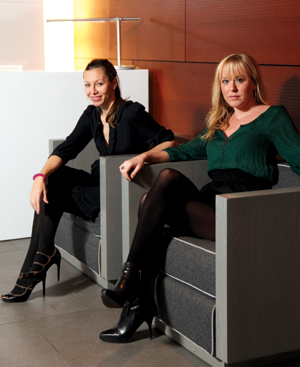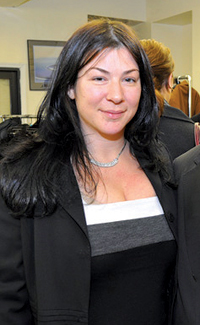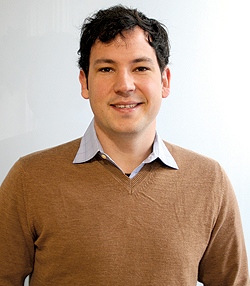Trending
Entrepreneurs rush into NYC real estate market
Social media sites, data collection firms among new start-ups launched<br>
Citi Habitats founder Andrew Heiberger’s well-funded new brokerage, Town Residential, made a splash when it debuted late last year. But the brokerage is far from the only new business in the city. The start of 2011 ushered in a flurry of new start-ups, many with innovative new business models related to New York City real estate.
Ironically, many of these models don’t involve actually doing deals. With prices down and fewer sales, entrepreneurs are looking for other ways to profit from the business of selling property.
In addition, lower start-up costs and the shuttering of older firms have made conditions ripe for new businesses, especially now that the market has started to bounce back, according to Greg Young, the former director of sales at Citi Habitats, who launched the Manhattan-based real estate training and consulting company Broker Heaven in June.
“The down market brought on some serious shakedowns in Manhattan,” Young said. “It’s a time of opportunity.”
New York City is a tough place for a new real estate-related business, however. With no traditional multiple listing service, it costs nearly $7,000 simply to get access to a listings feed from RealPlus, according to Matthew Daimler, the founder of Buyfolio, a new business that gives brokers and clients a Google Docs-type platform to share comments about listings. (note: clarification made)
“Anyone who wants this information has to go to RealPlus and pay them thousands of dollars to be able to get it,” Daimler said.
On top of that, many businesses from out of town have tried and failed to gain a foothold in New York, including the discount real estate agency Foxtons, a U.K.-based company that filed for bankruptcy protection in 2007 after a splashy foray into the New York market.
“This is a market where people want to know the brand they’re doing business with,” said Noah Rosenblatt, a well-known blogger and founder of property analytics platform UrbanDigs.com.
There are a number of new technology start-ups angling for a piece of the New York real estate market, Rosenblatt noted, due in part to the success of listings aggregator StreetEasy.
“You’re going to see a high amount of innovations come out,” he said. But along with that, “we may also see a decent failure rate.”
Below is a roundup of some of the new firms attempting to make a name for themselves.
Profit sharing

Ilan Bracha
In December, Prudential Douglas Elliman superbroker Ilan Bracha made waves by launching the first Manhattan franchise of the nationwide megafirm Keller Williams. The company has an unconventional profit-sharing model that, until recently, was virtually unheard of in Manhattan.
Agents, or “associates,” there receive a 70 percent commission split, and they pay no more than $50,000 to the house per year. The unusual part is that roughly half of the firm’s annual profits are paid to associates who have recruited other agents. The more profits their recruits generate, the more money they get.
And, once an associate has been with Keller Williams for more than three years, he or she can leave and still receive profit share. Future payments can even be passed on to children or grandchildren.
“One of the biggest fears of agents is, ‘How can I show 10 apartments a day for the rest of my life?'” noted Bracha. “[This] profit sharing is for life.”
Some have criticized the unconventional model for its similarities to multi-level marketing companies like Amway and Mary Kay. (Chris Heller, president of KW Worldwide, emphasized that Keller Williams is not a multi-level marketing company, since payments come from the company’s profits.)
The profit-sharing opportunities help motivate agents to recruit more people and do more deals, said Heller, adding that the company has large offices — some with up to 600 agents, which helps keep overhead low.
The model has quickly gained popularity: Keller Williams is now the third-largest residential real estate company in the country, with some 80,000 agents in North America. The Bayside, Queens-based Keller Williams Realty Landmark, which was founded in 2006, is now the largest real estate firm in the borough. Bracha, who plans to continue brokering at Keller Williams, said his goal is to have 250 agents in the first year.
The success of Keller Williams in other areas does not mean it will thrive in New York, noted Kathy Braddock, the cofounder of Rutenberg Realty and the real estate consulting firm Braddock+Purcell. “New York is such a different animal,” she said. “What tends to work in most of the country somehow doesn’t always work here.”
In an environment where brokers’ commissions are constantly being squeezed, profit sharing is gaining traction in Manhattan, often combined with high commission splits.
Last month, boutique firm Demsker Realty announced that it would offer 65 percent commission splits along with an end-of-year “profit bonus” and yearly referral bonuses. And, former Elliman broker Douglas Heddings last year founded his own firm, the Heddings Property Group, which has a business model based on 70 percent commission splits and sharing of the company’s net profits. The firm now has 14 agents in Manhattan and three in the Hamptons, and is “aggressively hiring,” Heddings said.
Catering to the very wealthy

Longtime friends Carastina DuBrovin, a former agent at Brown Harris Stevens, and Jennifer Kilmurray started Staunton DuBrovin in the fall to cater to wealthy pied-à-terre owners.
Newly launched Staunton DuBrovin is tapping into a market of wealthy jet-setters who need someone to take care of their pied-à-terres while they’re away.
The Manhattan-based firm was launched in September 2010 by longtime friends Carastina DuBrovin and Jennifer Kilmurray. Before starting the company, DuBrovin was a real estate agent at Brown Harris Stevens and Kilmurray worked for Quintessentially Concierge, a concierge service based in Manhattan and London.
With more international buyers picking up deeply discounted pied-à-terres in the downturn, the two saw an opportunity. Both noticed that their clients were asking for more help with everything from waiting for the cable guy to furnishing their newly purchased homes. When the duo launched Staunton DuBrovin, they had been providing these kinds of services to their clients individually for some time.
They now head a team of 11 employees — seven in New York and the Hamptons, two in Miami and two in Houston. When a client is coming into town, their staff can be on hand to stock the fridge, turn on lights, heat the pool or do a number of other tasks that Kilmurray said other concierge companies don’t do.
Recently, for example, a Miami client was about to leave for a ski trip when he realized that he needed long underwear. “We had one hour to get thermal underwear in Miami,” Kilmurray laughed.
While the firm caters to the very wealthy, Kilmurray said it’s actually a money-saver for many clients, since they can use their services as much or little as they need, rather than hiring a full-time staff. “We’re a cost-efficient way of managing your home,” she said, noting that the money-saving benefits are especially attractive in the down economy.
Payment plans are customized for individual clients. Some keep the firm on a monthly retainer, paying anywhere from $1,000 to $10,000. Others opt for an hourly rate of $60 to $120. The company currently manages 12 apartments in New York City, four homes in the Hamptons, six homes in Miami and three apartments in Houston, Kilmurray said.
Staunton DuBrovin has an office at 71 Gansevoort Street, but overhead is low, Kilmurray said, since staff is paid by the hour based on clients’ needs. She said the company has been profitable since it started, but she declined to say how much money the partners have invested.
The two founders are confident in the model because, while the real estate market may fluctuate, “there will always be people who have money,” DuBrovin said.
Real estate networking

Judy Sahagian
The slow market of the past two years has spawned a number of new real estate-related conferences and networking events.
These days, “there are very few barriers to entry for conferences, partly because the economy is so bad, and venues are starving to get anybody in the door,” said Patrick Healy, one of the organizers of RE BarCamp, an informal real estate “un-conference” first held in New York in 2009.
Likewise, in a down economy, agents are more likely to pay to attend networking events since they have more time on their hands and need new contacts.
“You have no listings, you have no showings, what are you going to do?” Healy said. “You want to get an education, you want to network, you want to go to these things. And if the price is kept down enough, you’re going to go.”
Companies such as NYC Network Group, which launched in 2009, are now hosting more local networking mixers. Manhattan-based GreenPearl.com — founded by former PropertyShark.com CEO Ryan Slack — started producing real estate networking events, forums and lectures in 2008.
But while GreenPearl’s mixers were well-attended — some drew as many as 900 attendees — Slack quickly lost interest in that business model.
“There’s not much money to be made when you’re charging $39 to $50 for an event, especially if you’ve got food and venue costs,” Slack said. Plus, he felt that large networking events don’t attract industry heavyweights, who are often uninterested in mingling with industry newbies.
So he spun off GreenPearl’s evening networking events business to former GreenPearl employee Judy Sahagian, who founded JudyNetworks.com last June. GreenPearl now focuses on high-end seminars and forums in New York and other major cities around the country, for which attendees pay $500 or more. The idea, Slack said, is that industry movers and shakers are willing to pay a premium to attend events with high-quality content and access to important contacts.
The company, which has nine employees and an 800-square-foot office space at 36 East 23rd Street, also makes money through sponsorships, and by hosting “private-label” events for other firms, Slack said. For example, GreenPearl produced an event for Massey Knakal in September, and has signed on to do three more.
Slack said the company is now profitable. To get it started, he said, he invested some of his PropertyShark earnings, but declined to say how much.
Real estate professionals have also found other new ways to help their businesses through relationship-building. The year-old Lucky Strikers Social Media Club, for example, is not a for-profit business, but rather a private network of real estate professionals based in the metro area. The group, which grew out of an informal dinner club of real estate pros interested in social media, has evolved into a chartered organization whose members refer business to each other.
Basically, “we have given each other access to each other’s Rolodexes,” said Healy, one of the founding members, adding that the group is the only one of its kind in New York. “All of our businesses have been helped by it.”
The Lucky Strikers’ membership is capped to ensure that members don’t compete with each other. (For example, there are two Manhattan brokers in the group, but Citi Habitats’s Sandy Edry focuses on Washington Heights, while Rutenberg Realty’s Malcolm Carter works farther downtown.)
Social media

Roost CEO Alex Chang
The past year has seen the rapid growth of new ventures aiming to help agents use social media to grow their business.
“Real estate agents are just in the first year of realizing how perfect Facebook is for doing referral business,” said Alex Chang, CEO and founder of Roost, a San Francisco-based company that recently launched a social media venture for real estate agents.
Roost started up in 2007 as a property search engine. But the company — which is funded by venture capital firms Shasta Ventures and General Catalyst Partners, and has raised some $13 million — rolled out its “Social Media Toolkit” in late 2010, and is now trying to get a toehold in the New York market. The new product helps agents set up a real estate tab on their Facebook page that links directly to their listings, and includes a publishing tool to help organize Facebook updates.
The basic Social Media Toolkit is free, but a recently unveiled premium version costs about $25 a month. The model is profitable when around 10 percent of users switch to the paid version, Chang said. The goal is to reach 20 percent, he said.
With the paid version available for about a month nationally, the conversion rate is now roughly 10 percent, Chang said, but any profits are being put back into the business.
Roost has around 25,000 real estate professionals using its platform. That includes 100 firms nationwide and hundreds of New York City professionals, Chang said.
With 25 employees, the company also offers social media training for agents and brokerages — Chang said he is currently in talks with The Corcoran Group and other New York City companies. Firms pay between $150 and $5,000 for Roost’s services, depending on how many agents they have.
Education

Greg Young
Just as networking events now seem to be popping up everywhere, more entrepreneurs are entering the real estate education space.
Until recently, many agents received little formal coaching beyond the 75 hours of training required to get their licenses. But in today’s difficult market, new businesses are looking to capitalize on brokers’ desire to stay ahead of the curve.
That’s what Young set out to do with Broker Heaven.
“I help agents make money — that’s what I do,” Young said. Six of the city’s real estate firms — A.C. Lawrence, CitySites New York, Mark David, Caliber Associates, Spire Group and Miron Properties — have now hired Broker Heaven to do the bulk of their training, he said.
Individual agents can also hire Young and attend the classes he offers. A sales training program for rental agents, for example, costs $500 per agent for two eight-hour classes, plus access to Broker Heaven’s online seminars. Young, who has an office and event space at 333 Park Avenue South, said around 100 individual agents have hired him thus far, in addition to the work he does for firms.
Young said he and part-owner Yvette Polanco invested a total of $125,000 in start-up capital, and the company is breaking even after six months in business.
In September, appraiser and data specialist Jonathan Miller announced the launch of MillerQA, a new real estate education company. His seminars, which cost $145 per person, are designed to provide analysis of housing data and explain how it relates to the New York market. The first seminar, held Jan. 19 at the Upper East Side’s Grolier Club, drew roughly 80 people.
Miller, founder of 24-year-old appraisal firm Miller Samuel, started MillerQA with four partners, including his wife and sister. He said the start-up costs for the new business were around $25,000, for expenses like the website and “i>clickers” that let attendees respond to electronic multiple-choice questions during seminars.
Why the sudden emergence of these new education companies? In addition to demand from agents, the Internet allows education-based businesses to easily expand their reach.
“You can do something like this without traveling across the country constantly,” said Young, who strives to make sure his online seminars are relevant outside New York.
Miller said he also expects much of MillerQA’s revenue to come from online seminars that viewers will be able to purchase for a subscription fee. “There’s more upside for profit potential because you can reach a larger audience,” he said.
Data collection

Noah Rosenblatt soft-launched the new UrbanDigs site in October, and has just over 100 subscribers, he said.
Though transparency has improved in recent years, Manhattan is still notorious for the absence of a true multiple listing service, and subsequent lack of available market data.
Lack of up-to-the-minute statistics frustrated Rosenblatt, a former equities trader who decided to try his hand at real estate in 2004.
“Every one of my clients asked me what the market was doing, and I had nothing to show them,” Rosenblatt recalled. Quarterly reports based on closed sales reflect market conditions from months earlier, he said, and they don’t offer data about specific market segments.
“I wasn’t able to say what the two-bedroom Upper East Side market was doing,” he said. “This really bothered me.”
So he created UrbanDigs
.com, a suite of analytical tools that track “pending sales” — contracts that have been signed but haven’t yet closed — as well as other market metrics.
It sounds simple, but it was no easy task. Rosenblatt said it took him a year to make sure his data was “clean” enough to give an accurate picture of the market. Now, he’s betting that brokers and consumers will be willing to pay for access to that information.
The new UrbanDigs site soft-launched in October, and has just over 100 subscribers, he said. It costs $20 per month for a full-access subscription, and Rosenblatt gives group discounts for firms. Warburg Realty recently became the first company to purchase a group package for its agents.
“My goal is to get every broker to use this tool,” Rosenblatt said.
But convincing brokers to fork over money in exchange for current market data has been harder than he thought. “In this business, brokers are being sold tools left and right,” he said. “They’re very hesitant to throw more money out for another tool that isn’t really well-known or proven.”
The main hurdle, he said, is getting agents to understand how access to the data will directly impact their bottom line. To overcome that obstacle, he’s been visiting real estate offices and speaking with groups of agents “to really explain how these new tools should be used, and how it’s going to help their business,” he said.
Over the long term, he said, he doesn’t expect subscriptions to provide the bulk of the firm’s profits. Eventually, he said, he wants to add a licensing component to the business, though he remained mum on further details.
UrbanDigs is also a brokerage that works with buyers, and Rosenblatt said he has around 13 clients right now.
Office listings

Sam Stein
While CoStar Group and LoopNet remain dependable sources for commercial leasing brokers in Manhattan, smaller tenants on the hunt for space often turn to the more rudimentary Craigslist when looking for new space.
But there’s a new company trying to make inroads with those tenants. Last year, after testing in a beta mode for about 12 months, Sam Stein launched OfficeDragon.com, a listings site for commercial property owners.
Stein, who’s the director of leasing for landlord Justin Management, said he saw an opening for a start-up because sites like Craigslist do not verify the listing agent. So the tenant may not always be sure the broker who listed the space is the bona fide broker.
“The first goal is to give property owners a clean and simple way to [market to] tenants,” said Stein, who financed the site himself. “The second is to give tenants a way to search for office space without going through the smoke and mirrors.”
As of last month, OfficeDragon had 138 buildings and about 250 spaces listed. That is out of approximately 2,000 Manhattan office buildings. By comparison, Cushman & Wakefield tracks roughly 1,500 Manhattan buildings.
There are also other firms getting into the commercial listings business for smaller spaces.
As The Real Deal has reported online, PropertyShark, for example, quietly started its own leasing service in 2009. As of the middle of last month, the company, which was just recently sold to California-based Yardi Systems, had about 2,400 buildings with available office space listed in Manhattan south of 59th Street. A review of the listings indicated that most are from Newmark Knight Frank. For the whole city, it had more than 3,000 office space listings. Retail had even more, with more than 3,500 listings in Manhattan alone. The listings are free, and the company said it hopes to profit with users signing up for additional services.
OfficeDragon’s fees range from about $10 per building per month to about $30 — based on the size of the property. Buildings smaller than 50,000 square feet list for free. About half the 138 properties registered less than 50,000 square feet. And based on the mix of buildings, The Real Deal estimated that the fees would yield approximately $10,000 to $20,000 a year in revenue. Stein declined to comment on revenues.
Stein is expecting to add to the site’s functionality this year. He plans to roll out TextDragon next month, which will allow potential tenants to get information on listings after texting a number. The fee-based service will include charges of $10 a month for landlords (both commercial and residential) to reserve key words that users can text in to get information about their listings. Landlords will also be charged additional fees every time someone receives a text about their property. And sometime during the summer, Stein wants to introduce video. While video and virtual tours have become common in the residential market, they are not used by any of the major commercial listings firms, such as CoStar, LoopNet or Mr. Office Space.
But Stein said it was difficult to get traction for the new company with many of his competitors much more established. In fact, he has listed properties on OfficeDragon as a broker for Justin Management, and although he is getting more tour requests from it, he has not closed a lease yet. By Adam Pincus
Streamlining investing

Manish Patel, left, and Ryan Hinricher
Manish Patel and Ryan Hinricher are the founders of Investor Nation, a successful wholesale real estate sales and consulting company. Many investors in residential real estate are amateur or part-timers, they noticed, and often use “pretty unsophisticated” methods to determine whether or not to purchase properties, Patel said.
For example, many don’t account for costly repairs or longer-than-expected vacancies, Patel said. In his opinion, those mistakes are partially responsible for the current rash of foreclosures.
“I’ve seen too many 401(k)s go down the tubes because people were not savvy enough to make the right decisions,” he said.
Purchasers of commercial real estate have complicated models that let them weigh various factors before deciding whether to purchase a property. But there are no similar models on the residential side, Patel said. So he built an Excel model for residential investment purchases, which eventually evolved into RealYields. The website soft-launched in August, and was officially unveiled in December.
While the Austin, Tex.-based company is national, it has a satellite office in New York, which the partners view as an opportune place for doing business because of the large number of real estate professionals.
Here’s how RealYields works: Sellers list their properties on the website for $27 to $97 per month, depending on the number of listings. Potential buyers pay a monthly fee of $7 to $17 to peruse the properties for sale. Then, they can use the site’s tools to figure out whether or not the property is a good deal, based on factors like the cost of potential repairs, loan terms and the home’s appraised value.
The site includes how-to videos that give newbie buyers instructions on different parts of the process, like structuring bids for contractors.
The business model is simple. “We’re trying to get a lot of people to spend a little money,” Patel said. Much of their investment so far has been time; they estimate it’s taken about $250,000 worth of labor to get the site up and running. All of the company’s marketing so far has been through social media — they haven’t done any traditional advertising, and don’t expect to.
“If we have a few thousand people paying $7 per month, we’re okay,” Patel said.
RealYields now has “hundreds” of users, Patel said. And the company, which has six employees, just announced a partnership with BiggerPockets, a website for real estate investors with around 60,000 registered users nationwide.
Buyer-broker communication

Matthew Daimler
Another new site, Buyfolio, is targeting New Yorkers looking to buy rather than rent. The company has a slightly different perspective on revenues.
“Our focus point was, let’s build a product that people use and like, and we’ll worry about how to monetize it second,” said Daimler. He has the luxury of such an approach because he created the website SeatGuru.com, a guide to airplane seating that had an audience of millions by the time he sold it to Expedia in 2007. Daimler declined to disclose how much he sold SeatGuru for, but said he “had a very good exit.”
He and his wife took their earnings and moved from Seattle to New York, where they bought a loft in Soho. They got the idea for Buyfolio when they noticed how confusing it was to keep track of the listings they’d seen. They decided to create software that gives brokers and clients a common platform where they can both comment on listings, “like a spreadsheet that’s always updated,” Daimler said.
Buyfolio has four full-time developers who work remotely; Daimler works out of his Soho loft. A number of New York City brokers already use the service, including the Heddings Property Group. And this spring, Daimler said, he will likely start charging brokers a subscription fee.
Making it easier to rent an apartment

Don Tallerman, the founder of Urban Edge, has some 4,000 New York rental listings on his new site. Landlords Glenwood, the Brodsky Organization and Manhattan Skyline have all signed on.
A new crop of start-up businesses are looking to turn a profit by making the New York apartment-hunting process easier.
Two new listings websites, Urban Edge and Naked Apartments, are hoping to capitalize on the massive rental market here.
“The majority of New Yorkers rent, and average rent in New York is the highest in the country,” said Joe Charat, one of the cofounders of Naked Apartments, which officially launched in June 2010. “Just multiply those things and you see it’s an enormous market. If you can create a solution to make that process easier, it’s going to be lucrative, for sure.”
Other websites have tried to capture the New York rental market in the past, and none except StreetEasy (which focuses on sales) have really caught on. One reason is that Craigslist has long served as a free resource for roommates or no-fee apartments.
But Craigslist is now so popular in New York that it’s become “a Wild West shit-show,” with hundreds of duplicate listings and brokers reposting each day to get to the top of the site, said Urban Edge founder Don Tallerman. (He said Craigslist works better in cities where the rental market is a small subset of the market rather than a separate, competitive market unto itself.)
Tallerman, the president of the consulting firm Online Marketing Group, launched UrbanEdgeNY.com in April 2010. The site, which now has some 4,000 New York rental listings, is free for owners and consumers. Landlords Glenwood, the Brodsky Organization and Manhattan Skyline all post their listings on the site.
Consumers can browse listings and contact owners directly — no brokers are allowed. So far, about 400 property owners have posted their listings on the site, he said.
Revenues come from the marketing services, which owners can purchase à la carte. For example, Urban Edge offers to help owners with their ads, e-mail marketing or search engine optimization.
So far, “our revenue model seems to be really working,” Tallerman said, adding that Urban Edge is now breaking even. He said he has invested about $400,000 in the new company.
Naked Apartments is free for renters, but costs brokers and landlords $9 to $59 per month to post their listings on the site. The site currently has more than 10,000 listings for unique rental apartments in New York City, Charat said. A Google-like ranking system organizes search results based on relevance, rather than when they were posted.
Charat declined to share specifics about start-up costs, but said most of the site’s expenses have come from salaries for the three-man team and marketing on sites like Google and Facebook.
New software for landlords

David Vivero
San Francisco-based RentJuice, which launched in New York City last month, has a similar mission to Urban Edge and Naked Apartments. But rather than serving consumers, the online platform is aimed at rental brokers and landlords.
Founded in 2009, RentJuice has thousands of users in Boston, Chicago and Miami, and the platform is being used to market some $4 billion in annual lease value, according to RentJuice CEO David Vivero. The 18-employee company has reportedly received at least $300,000 in financing from investors, including the well-known venture capitalist Tim Draper of Draper Fisher Jur-vetson.
Vivero, who grew up helping his family manage Miami Beach apartment buildings, got the idea for RentJuice while at Harvard Business School in 2008. He noticed that landlords communicate with rental brokers primarily by e-mailing or faxing listings. RentJuice speeds up the process by allowing rental brokers, property managers and landlords to use the same online software, which lets them share information instantly, he explained. For example, when an apartment is rented or the price changes, the landlord enters the information into RentJuice, and can instantly share it with the brokerages of his choosing.
RentJuice “can save everybody a lot of time and a lot of phone calls,” said Scott Solomon, the CEO of Manhattan-based landlord Pan Am Equities, which started using RentJuice last month.
In a model similar to that of Roost, Urban Edge and Naked Apartments, landlords can input their listings into RentJuice for free, and brokers can see them for free. Revenues are generated when users elect to use the site’s paid features, like exporting listings to sites like Craigslist or Trulia, or pulling renters’ credit reports. Users pay an average of $30 to $40 per agent per month for the additional features, Vivero said.
The company is not releasing any information about its profitability to the public, but Vivero said RentJuice has been “generating significant revenues” for the past 18 months.




